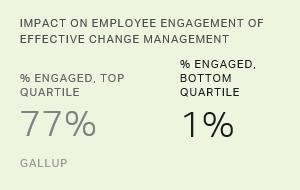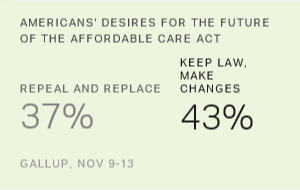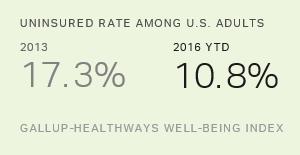Story Highlights
- The healthcare industry is undergoing major transformations
- Amid rapid change, employees are left to wonder what's expected of them
- Hospitals should address employees' needs and build engagement
President-elect Donald Trump's arrival in the White House will likely bring changes to the Affordable Care Act (ACA). In fact, Trump has vowed to repeal and replace the law in the first days of his presidency.
While the ACA's future is unclear and public opinion remains divided over the law, one thing is certain: The healthcare industry will undergo more transformation in the years ahead.
During the past six years in which the law has been in effect, the impact of the many initiatives associated with the ACA on healthcare organizations and their workers has not been trivial.
Rapid Changes Have Adverse Effects
Through Gallup's work with healthcare organizations, consultants have observed that the rapid changes in the healthcare industry have adversely affected two critical items of employee engagement: knowing work expectations and connecting with the company's mission. These two items have shown a steady decline across a number of healthcare organizations.
Further complicating matters, the ACA's newly insured population is expected to require at least 8,000 additional primary care physicians to meet their needs, according to a research study by the Heritage Foundation. Even with the use of nurse practitioners (NPs) and physician assistants (PAs), projected shortages range from 20,400 to 45,000 primary care physicians over the next decade.
"Having to do more with less" is a phrase that is repeated by leaders across the healthcare system. The ACA brought about many changes in healthcare, and 2015 recorded the highest number of healthcare-related merger and acquisition deals in recent history.
Physicians and healthcare professionals continue to have serious concerns about the consolidation across healthcare. They see the risk that very large organizations may manage their staffs without valuing the wisdom of their front-line employees. Already many doctors are frustrated by electronic medical records, strategic planning and hospital processes that they feel have marginalized their medical insights into their own patients.
Connecting Mission With Margin
In the midst of all these changes in the healthcare industry, Gallup continues to study the most engaged healthcare workplaces to assess how leaders of these organizations are managing their workforces.
Whether more changes will come about because of the ACA or its possible repeal, or other initiatives, employee engagement must be a top priority.
As noted in a prior Gallup.com article, "Effective change management can enhance employee engagement, even during times of uncertainty. Nearly eight in 10 employees (77%) are engaged when workers strongly agree there is open communication, opportunities to provide input, a clear connection between current changes and the company's future, and management support for changes that affect their workgroup. When employees strongly disagree, a mere 1% are engaged."
Unclear Expectations Cause Anxiety, Confusion
Understanding work expectations is foundational to employee engagement. Unclear expectations can cause anxiety and confusion, resulting in low engagement. As hospital leaders grapple to implement large-scale changes while cutting costs, clarifying employees' expectations while also connecting change with the organization's mission is even more vital.
Through qualitative research sessions across a number of healthcare organizations, Gallup identified three key employee concerns that hospital leaders need to address as they navigate changes in their industry:
-
Why is my company changing the way we have always operated?
-
What role will I play in the change process?
-
How will the change affect me?
Gallup research shows a relationship between high engagement levels and confidence in a company's future. If engagement drops because of mismanaging employees' feelings of fear and uncertainty, the company can be at risk for lost productivity, negative patient experiences and flight of top talent.
To balance the mission of medicine with margin -- and to keep top employees -- leaders need to focus on their people and address their employees' most basic needs through communication and support to increase engagement.
What Top-Performing Healthcare Organizations Do Differently
Gallup's work with the most highly engaged healthcare organizations reveals four organizational strengths that set them apart from their peers as they weather the changes in their industry:
-
Clear and open communication across the organization. Leaders of top healthcare systems communicate the need for change as it relates first to the overall business, and second to every individual within the organization. Creating buy-in at the managerial level is crucial, as is allowing employees to be integral to the change process by actively eliciting avenues for feedback. This information and communication strategy should help allay employees' fears of the future and keep them from leaving.
-
A well-articulated mission and purpose that is consistent with the organization's culture. Whichever beliefs top management wants to build into its purpose statement must be demonstrated in practice. To make the guidelines effective, executives and leaders at all levels should articulate the company's philosophy, relate it to actual situations and problems at hand, and point out to associates where their actions align with the beliefs of the organization.
-
A clear commitment from leadership to create great workplaces. The best organizations know how to establish emotional commitments with their employees to create an environment where people love their work. Engaging employees is their top priority because they know that engagement drives better business outcomes.
-
A strong commitment to the community. Community engagement makes the hospital a stakeholder in the health and wellness of its local communities while building patient confidence in the healthcare provider. This strategy allows employees to live their mission by supporting the health and wellness of their communities, and allows community members to see evidence that the healthcare organization values patient outcomes. These factors are key components in creating a competitive advantage.
Top-performing healthcare organizations provide credible, continual and personalized communication about mission and purpose to build employee engagement even as they face industrywide challenges. This strategy makes them better equipped to weather changes while consistently outperforming their peers in patient satisfaction and financial returns.




